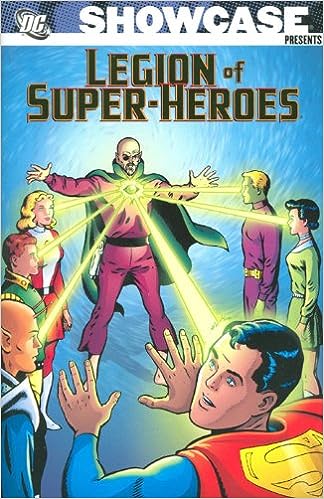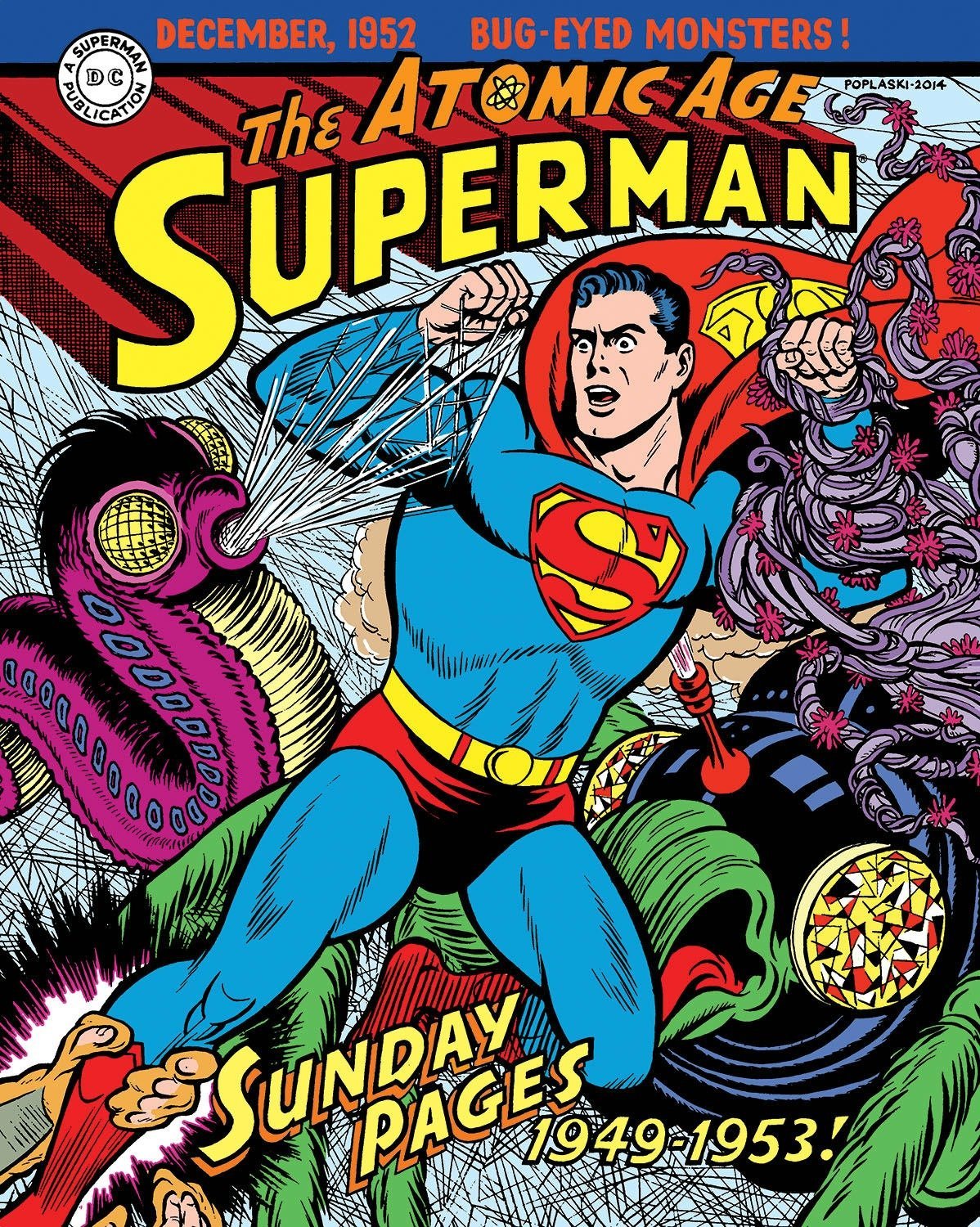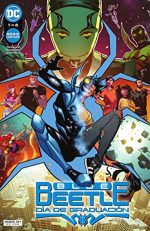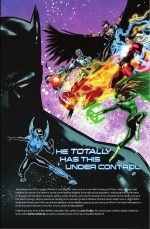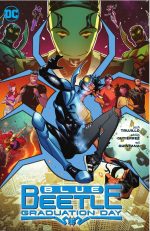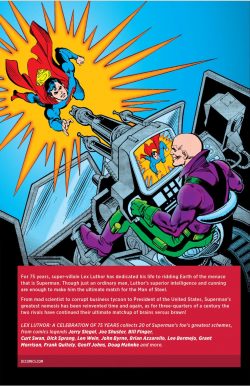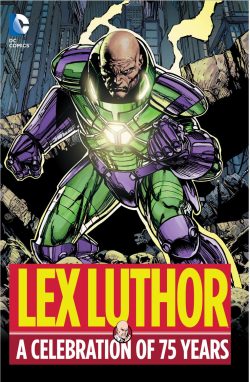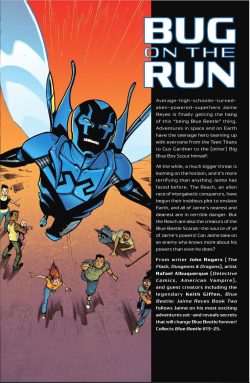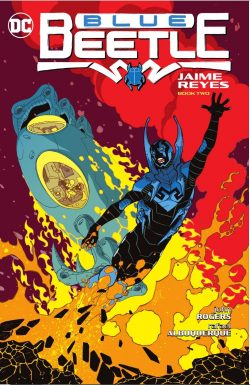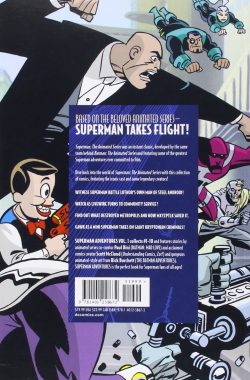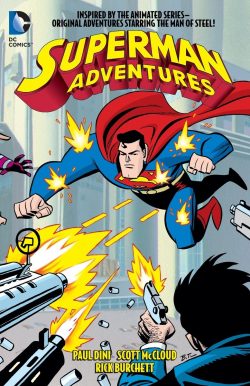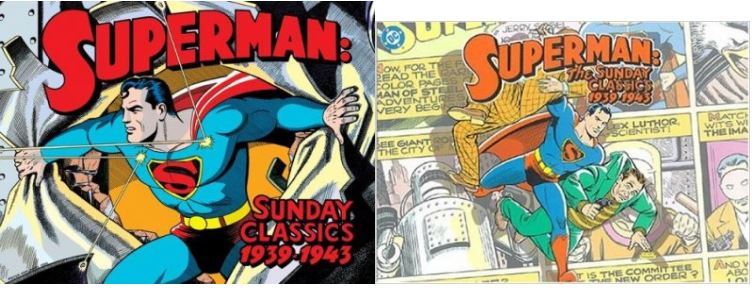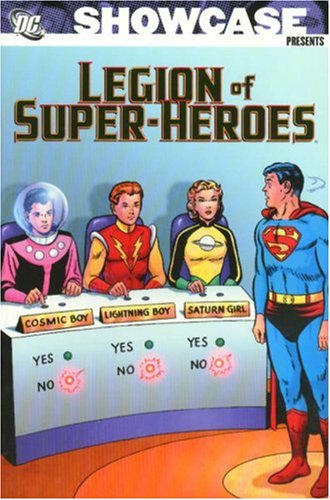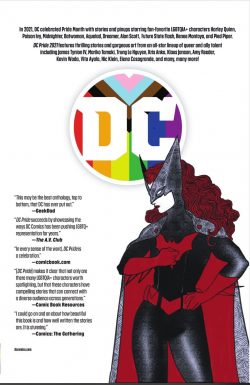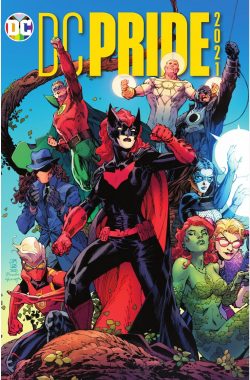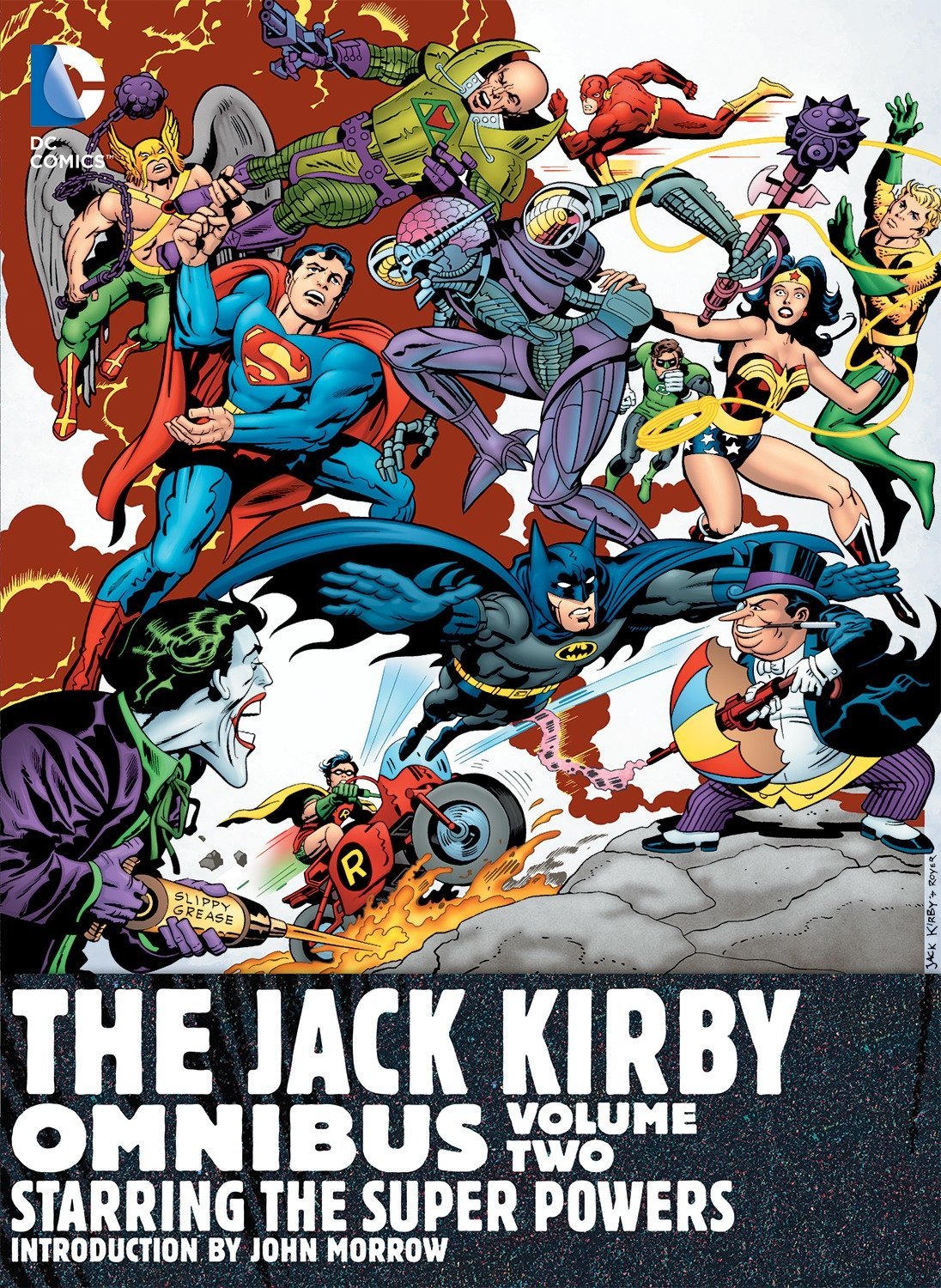
By Jack Kirby, with Mike Royer, D. Bruce Berry, Wally Wood, Pablo Marcos, Adrian Gonzalez, Greg Theakston, Alex Toth, Vince Colletta, Joe Simon, Denny O’Neil, Martin Pasko, Steve Sherman, Michael Fleisher, Joey Cavalieri, Paul & Alan Kupperberg, Bob Rozakis & various (DC Comics)
ISBN: 978-1-4012-3833-9 (HB)
Famed for larger-than-life characters and gigantic, cosmic imaginings, Jack Kirby was an astute, imaginative, spiritual man who lived through poverty, gangsterism, the Depression, Post-War optimism, Cold War paranoia, political cynicism and the birth and death of peace-seeking counter-cultures. He was open-minded and utterly wedded to the making of comics stories on every imaginable subject. He always believed that sequential narrative was worthy of being published as real books beside mankind’s other literary art forms.
History has proved him right, and showed us just how ahead of the times he always was.
There’s a magnificent abundance of Kirby commemorative collections around these days (though still not all of it, so I remain a partially disgruntled dedicated fan). This particular magnificent hardback compendium re-presents most of the miscellaneous oddments of the “King’s DC Canon”; or at least those the company still retains rights for. The licenses on stuff like his run on pulp adaptation Justice Inc. (and indeed Marvel’s 2001: A Space Odyssey comic) will not be forthcoming any time soon…
Some of the material here is also available in 2019’s absolutely monster DC Universe Bronze Age Omnibus by Jack Kirby, but since it isn’t available digitally either (yet), you’d best have strong wrists and a sturdy desk at hand for that one.
Happily, this less massive tome from 2013 is less of a strain physically or financially. It opens with pages of hyper-kinetic Kirby pencil pages and a moving ‘Introduction by John Morrow’ before hurtling straight into moody mystery with a range of twice told tales.
On returning from WWII, Kirby reconnected with long-term creative partner Joe Simon. National Comics/DC was no longer a welcoming place for the reunited dream team supreme and by 1947 they had formed their own studio. Subsequently enjoying a long and productive relationship with Harvey Comics (Stuntman, Boy’s Ranch, Captain 3-D, Lancelot Strong, The Shield, The Fly, Three Rocketeers and more) the duo generated a stunning variety of genre features for Crestwood/Pines supplied by their “Essankay”/ “Mainline” studio shop.
Triumphs included Justice Traps the Guilty, Fighting American, Bullseye, Police Trap, Foxhole, Headline Comics and especially Young Romance amongst many more: a veritable mountain of mature, challenging strip material in a variety of popular genres.
One was mystery and horror, and amongst the dynamic duo’s Prize Comics concoctions was noir-informed, psychologically-underpinned supernatural anthology Black Magic – and latterly, short-lived yet fascinating companion title Strange World of Your Dreams.
These comics anthologies eschewed traditional gory, heavy-handed morality plays and simplistic cautionary tales for deeper, stranger fare, and – until the EC comics line hit their peak – were far and away the best mystery titles on the market.
When the King quit Marvel for DC in 1970, his new bosses accepted suggestions for a supernatural-themed mature-reading magazine. Spirit World was a superb but poorly received and largely undistributed monochrome magazine. Issue #1 – and only – appeared in the summer of 1971, but editorial cowardice and backsliding scuppered the project before it could get going.
Material from a second, unpublished issue eventually appeared in colour comic books Weird Mystery Tales and Forbidden Tales of Dark Mansion, but with his ideas misunderstood, ignored or side-lined by the company, Kirby reverted to more traditional fare. Never truly defeated though, he cannily blended his belief in the marketability of the supernatural with flamboyant superheroics to create another unique and lasting mainstay for the DC universe. The Demon only ran a couple of years but was a concept later talents would make a pivotal figure of the company’s continuity.
Jack’s collaborations with fellow industry pioneer Joe Simon always produced dynamite concepts, unforgettable characters, astounding stories and huge sales, no matter what genre avenues they pursued, blazing trails for so many others to follow and always reshaping the very nature of American comics with their innovations and sheer quality.
As with all their endeavours, Simon & Kirby offered stories shaped by their own sensibilities. Identifying a “mature market” gap in the line of magazines they autonomously packaged for publishers Crestwood and Prize, they realised the sales potential of high-quality spooky material. Thus superb, eerily seminal Black Magic debuted with an October/November 1950 cover-date; supplemented in 1952 by boldly obscure psychological drama anthology The Strange World of Your Dreams. This title was inspired by studio-mate Mort Meskin’s vivid and punishing night terrors: dealing with fantastic situations and – too frequently for comfort – unable or unwilling to provide pat conclusions or happy endings. There was no cosmic justice or calming explanations available to avid readers. Sometimes The Unknown just blew up in your face and you survived – or didn’t. No one escaped whole or unchanged…
Thus, this colossal compendium of cult cartoon capers commences with DC’s revival of Black Magic as a cheap, modified and toned down reprint title.
The second #1 launched with an October/November 1973 cover-date, offering crudely re-mastered versions of some astounding classics. Benefitting from far better reproduction technology here is ‘Maniac!’ (originating in Black Magic #32 September/October 1973): an artistic tour de force and a tale much “homaged” by others in later years, detailing how and why a loving brother stops villagers taking his simple-minded sibling away. This is followed by ‘The Head of the Family!’ (BM #30 May/June 1954, by Kirby & Bruno Premiani) exposing the appalling secret shame of a most inbred clan…
DC’s premier outing ended with a disturbing tale first seen in Black Magic #29 (March-April 1954). Specifically cited in 1954’s anti-comic book Senate Hearings, ‘The Greatest Horror of them All!’ told a tragic tale of a freak hiding amongst lesser freaks…
Cover-dated December 1973/January 1974, DC’s second shot opened with ‘Fool’s Paradise!’ (BM #26, September/October 1953) as a petty thug stumbles into a Mephistophelean deal and reveals how ‘The Cat People’ (#27 November/December 1953) mesmerised and forever marked an unwary tourist in rural Spain before ‘Birth After Death’ (#20 January 1953) retold the true tale of how Sir Walter Scott’s mother survived premature burial, and ‘Those Who Are About to Die!’ (#23 April 1953) sketched out how a painter could predict imminent doom…
‘Nasty Little Man!’ (#18 November 1952) fronted DC’s third foray and gets my vote for creepiest horror art job of all time. Here three hobos discover to their everlasting regret why you shouldn’t pick on short old men with Irish accents. ‘The Angel of Death!’ (#15 August 1952) then details an horrific medical mystery far darker than mere mystic menace…
In the 1950s, as their efforts grew in popularity, S & K were stretched thin. Utilising a staff of assistants and crafting fewer stories themselves meant they could keep all their deadlines.
The ‘Cover art for Black Magic #4, June/July 1974’ swiftly segues into ‘Last Second of Life!’(Black Magic volume 1 #1, October-November 1950 and their only narrative contribution to that particular DC issue) wherein a rich man, obsessed over what the dying see at their final breath, soon regrets the unsavoury lengths he went to in finding out…
There were two in the next issue. ‘Strange Old Bird!’(courtesy of Black Magic #25 June/July 1953) is a gently eerie thriller of a little old lady who gets the gift of renewed life from her tatty and extremely flammable feathered old friend and ‘Up There!’ from the landmark 13th issue (June 1952) – the saga of a beguiling siren stalking the upper stratosphere and scaring the bejabbers out of a cool test pilot…
DC issue #6 reprises ‘The Girl Who Walked on Water!’ (BM #11 April 1952), exposing the immense but fragile power of self-belief whilst the ‘Cover art for Black Magic #7, December 1974/January 1975’ (originally #17 October 1952) provides a chilling report on satanic vestment ‘The Cloak!’ (BM #2 December 1950/January 1951) and ‘Freak!’ (also from #17) shares a country doctor’s deepest shame…
DC’s #8 revisited The Strange World of Your Dreams, beginning with “typical insecurity nightmare” ‘The Girl in the Grave!’ (#2, September/October 1952). The Meskin-inspired anthology of oneiric apparitions eschewed cheap shocks, mindless gore and goofy pun-inspired twist-ending yarns in favour of dark, oppressive suspense, soaked in psychological unease and tension over teasing…
Following up with ‘Send Us Your Dreams’ from the same source (requesting readers’ ideas for spokes-parapsychologist Richard Temple to analyse), DC’s vintage fear-fest concludes with # 9 (April/May 1975) and ‘The Woman in the Tower!’ as originally seen in SWoYD #3, (November/December 1952) detailing the symbolism of oppressive illness…
When his Fourth World Saga stalled, Kirby continued creating new material with Kamandi – his only long-running DC success – and explored WWII in The Losers whilst creating the radical, scarily prophetic, utterly magnificent Omac: One Man Army Corps, but still could not achieve the all-important sales the company demanded. Eventually he was lured back to Marvel and new challenges like Black Panther, Captain America, 2001: A Space Odyssey, Devil Dinosaur, Machine Man and especially The Eternals.
Before that though, he unleashed new concepts and even filled in on established titles. As previously moaned about, however, his 3-issue run on Justice Inc. – adapting 1930s’ licensed pulp star The Avenger – is not included here, but at least his frankly astounding all-action dalliance with martial arts heroics is…
Inked by D. Bruce Berry and debuting in all-new try-out title 1st Issue Special #1 (April 1975), ‘Atlas the Great!’ harked back to the dawn of human civilisation and followed the blockbusting trail of mankind’s first super-powered champion in a blazing Sword & Sorcery yarn.
1st Issue Special #5 (August 1975, Berry) highlighted the passing of a torch as a devout evil-crusher working for an ancient justice-cult retired and tipped his nephew – Public Defender Mark Shaw – to become the latest super-powered ‘Manhunter’, after which a rare but welcome digression into comedy manifested as ‘The Dingbats of Danger Street (1st Issue Special #6, September 1975). With Mike Royer inking, Kirby unleashed a bizarre and hilarious revival of his Kid Gang genre, starring four multi-racial street urchins united for survival and to battle surreal super threats…
Kirby – and Berry – limned the third issue of troubled martial arts series Richard Dragon, Kung Fu Fighter (August/September 1975). Scripted by Denny O’Neil, the savage shocker pits the lone warrior against an army of assassins in ‘Claws of the Dragon!’…
‘Fangs of the Kobra!’ comes from Kobra #1, released with a February/March 1976 cover-date. The tale is strange in both execution and delivery, with Kirby’s original updating of Dumas’ tale The Corsican Brothers reworked by Martin Pasko, Steve Sherman and artists Pablo Marcos & Berry.
It introduces brothers separated at birth. Jason Burr grew up a normal American kid whilst his twin – stolen by an Indian death cult – was reared as Kobra, the most dangerous man alive. Sadly for the super-criminal, young adult Jason is recruited by the authorities because of a psychic connection to the snake lord: a link allowing them to track each other and also feel and experience any harm or hurt the other experiences…
When Simon & Kirby came to National/DC in 1942 one of their earliest projects was revitalising the moribund Sandman strip in Adventure Comics. Their unique blend of atmosphere and dynamism made it one of the most memorable, moody and action-packed series of the period (as you can see by reading their companion volume The Sandman by Simon & Kirby).
The band was brought back together for The Sandman #1 (cover-dated Winter 1974): a one-shot project which kept the name but created a whole new mythology. Scripted by Simon and inked by Royer, ‘General Electric’ revealed how the realm of dreams was policed by a scarlet-&-gold super-crusader dedicated to preventing nightmares escaping into the physical world. With unwilling assistants Glob and Brute, the Sandman also battled real world villains exploiting the unconscious Great Unknown. The heady mix was completed by frail orphan Jed, whose active sleeping imagination seemed to draw trouble to him.
The proposed one-off was a minor hit at a tenuous time in comics publishing, and DC kept it going, even though the originators were not interested. Kirby & Royer did produce the ‘Cover art Sandman #2, April/May 1975’ and ‘Cover art Sandman #3, June/July 1975’ before the King returned to the series with #4.
‘Panic in the Dream Stream’ – August/September 1975 – was scripted by Michael Fleisher, and revealed how a sleepless alien race attempted to conquer Earth through Jed’s fervent dreams: a traumatic channel that also allowed them to invade Sandman’s Dream Realm. The next issue (October/November 1975) heralded an ‘Invasion of the Frog Men!’ into an idyllic parallel dimension whilst the next reunited a classic art team. Wally Wood inked Jack for Fleisher’s ‘The Plot to Destroy Washington D.C.!’. Here mind-bending cyborg Doctor Spider subverted and enslaved Glob and Brute in his eccentric ambition to take over America…
Although Sandman #6 (December 1975/January 1976) was the last published issue, another tale was already completed. It finally appeared in reprint digest Best of DC #22 (March 1982). ‘The Seal Men’s War on Santa Claus’ with Fleisher scripting and Royer handling the brushwork was a sinister seasonal romp with Jed’s wicked foster-family abusing him in classic Scrooge style before the Weaver of Dreams summons him to help save Christmas from bellicose well-armed aquatic mammals…
During the 1980s costumed heroes stopped being an exclusively print cash cow. Many toy companies licensed Fights ‘n’ Tights titans and reaped the benefits of ready-made comic book spin-offs. DC’s most recognizable characters morphed into a top-selling action figure line and were inevitably hived off into a brisk and breezy, fight-frenzied miniseries.
Super Powers launched in July 1984 as a 5-issue miniseries with Kirby covers and his signature characters prominently represented. Jack also plotted the stellar saga with scripter Joey Cavalieri providing dialogue, and Adrian Gonzales & Pablo Marcos illustrating a heady cosmic quest comprising numerous inconclusive battles between agents of Good and Evil.
In ‘Power Beyond Price!’, ultimate nemesis Darkseid despatches four Emissaries of Doom to destroy Earth’s superheroes. Sponsoring Lex Luthor, The Penguin, Brainiac and The Joker the monsters jointly target Superman, Batman & Robin, Wonder Woman, The Flash, Aquaman and Hawkman…
The combat escalates in #2’s ‘Clash Against Chaos’ with the Man of Steel and Scarlet Speedster tackling Luthor, whilst Aquaman and Green Lantern pummel the Penguin as Dark Knight and Winged Wonder confront a cosmically-enhanced Harlequin of Hate…
With Alan Kupperberg inking, an inconclusive outcome leads to a regrouping of evil and an attack by Brainiac on Paradise Island. With the ‘Amazons at War’ the Justice League rally until Superman is devolved into a brutal beast who attacks his former allies. All-out battle ensues in ‘Earth’s Last Stand’, before Kirby stepped up to write and illustrate the fateful finale: cosmos-shaking conclusion ‘Spaceship Earth – We’re All on It!’ (November 1984, with Greg Theakston suppling inks)…
A bombastic Super Powers Promotional Poster leads into a nostalgic reunion as DC Comics Presents #84 (August 1985) reunited Jack with his first “Fantastic Four”. ‘Give Me Power… Give Me Your World!’ – written by Bob Rozakis, Kirby & Theakston (with additional art by the legendary Alex Toth) – pits Superman and the Challengers of The Unknown against mind-bending Kryptonian villain Zo-Mar, after which the ‘Cover art for Super DC Giant S-25, July/ August 1971’ (inked by Vince Colletta) segues into the Super Powers miniseries, spanning September 1985 to February 1986.
Scripted by Paul Kupperberg the Kirby/Theakston saga ‘Seeds of Doom!’ recounts how deadly Darkseid despatches techno-organic bombs to destroy Earth, requiring practically every DC hero to unite to end the threat.
With squads of Super Powers travelling to England, Rome, New York, Easter Island and Arizona the danger is magnified ‘When Past and Present Meet!’ as the seeds warp time and send Aquaman and the Martian Manhunter back to days of King Arthur…
Issue #3 (November 1985) finds Red Tornado, Hawkman and Green Arrow plunged back 75 million years in ‘Time Upon Time Upon Time!’ even as Doctor Fate, Green Lantern and Wonder Woman are trapped in 1087 AD, battling stony-faced giant aliens on Easter Island.
Superman and Firestorm discover ‘There’s No Place Like Rome!’as they battle Darkseid’s agent Steppenwolf in the first century whilst Batman, Robin and Flash visit a future where Earth is the new Apokolips for #5’s ‘Once Upon Tomorrow’, before Earth’s scattered champions converge on Luna to spectacularly squash the schemes-within-schemes of ‘Darkseid of the Moon!’ …
Rounding out the astounding cavalcade of wonders is a selection of Kirby-crafted Profiles pages from Who’s Who: The Definitive Directory of the DC Universe 1985-1987: specifically, Ben Boxer, the Boy Commandos, Challengers of the Unknown, Crazy Quilt, Etrigan the Demon, Kamandi, The Newsboy Legion, Sandman (the Dream Stream version from 1974), Sandy, the Golden Boy and Witchboy Klarion.
Kirby was and remains unique and uncompromising. His words and pictures comprise an unparalleled, hearts-and-minds grabbing delight no comics lover can possibly resist. If you’re not a fan or simply not prepared to see for yourself what all the fuss has been about then no words of mine will change your mind.
That doesn’t alter the fact that his life’s work from 1937 to his death in 1994 shaped the entire American comics scene – and indeed the entire comics planet – affecting the lives of billions of readers and thousands of creators in all areas of artistic endeavour for generations and is still winning new fans and apostles every day, from the young and naive to the most cerebral of intellectuals. His work is instantly accessible, irresistibly visceral, deceptively deep and simultaneously mythic and human.
He is the King and will never be supplanted.
© 1971, 1973, 1974, 1975, 1976, 1984, 1985, 1986, 1987, 2013 DC Comics. All Rights Reserved.
